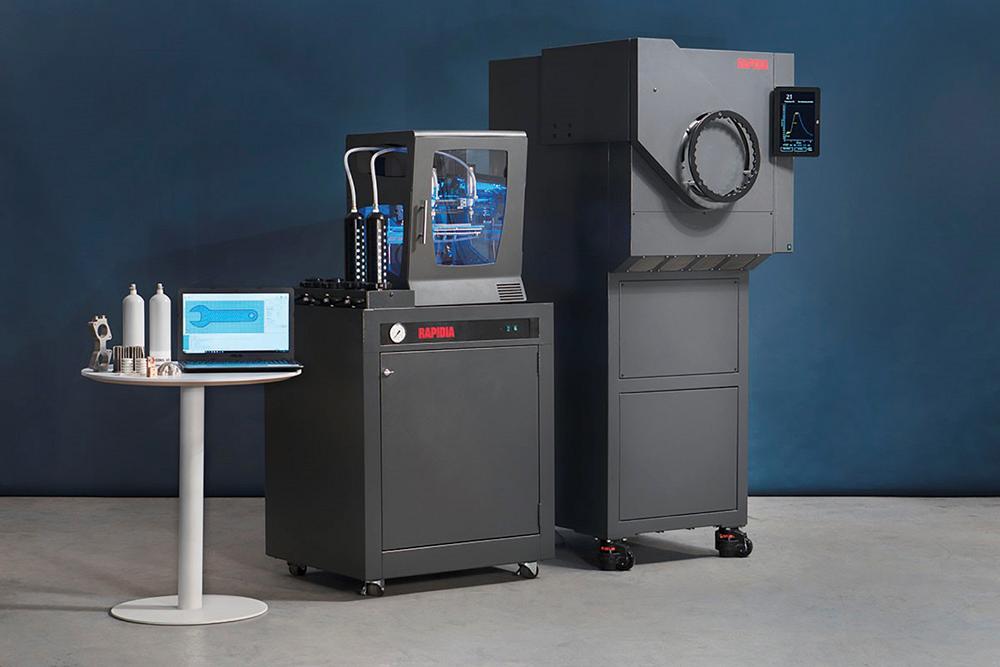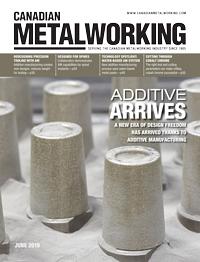- FMA
- The Fabricator
- FABTECH
- Canadian Metalworking
Technology Spotlight: Water-based AM system
New additive manufacturing process uses water-based metal paste
- By Canadian Metalworking
- July 16, 2019
- Article
- Metalworking

The two-step Rapidia system takes parts directly from the 3D printer to a sintering furnace, and eliminates the need for debinding
Additive manufacturing (AM) is a novel process that creates parts by building upward from a base, layer by layer, until a complete form is finished. It is a process that traditionally has been viewed as a slow, methodical way to produce complex parts with internal features, parts that cannot be created using other manufacturing technologies.
Rapidia, Vancouver, has introduced a new AM system to 3D print strong, complex metal parts for prototyping and end-use applications using a water-based metal paste, rather than the powders and wires typically used in AM applications.
Recognizing that existing “office-friendly” metal 3D printers typically require a chemically intensive and lengthy debinding process, a procedure that treats the finished parts in a chemical solvent, the Rapidia team set out to develop a system that quickly creates strong, intricate parts in an environmentally friendly manner. The company’s AM system even can be installed in a normal office environment.
According to the manufacturer, the result is the only 3D printing system to use a water-based metal paste, which can create parts faster than other AM systems. This new approach makes metal 3D printing accessible to users outside of large-scale industry and unlocks the potential to deliver critical parts the next day.
The metal paste is safe to handle and reduces the overall time needed to produce parts, the company states.
“The Rapidia team has developed a completely solvent-free process that quickly and affordably prints high-quality metal parts using a system that is practical to use in a normal office,” said Rapidia founder Dan Gelbart. “While metal 3D printing systems based on metal injection moulding techniques have made great advances in recent years, we saw an opportunity to create a completely new process that is office-friendly, eliminates chemical solvents, and speeds up production.”
The two-step system takes parts directly from the 3D printer to a sintering furnace, removing the need for debinding. According to the manufacturer, this, in combination with other time-saving innovations, enables parts to be produced up to twice as fast as bound-metal and laser AM processes.
Operating costs are reduced by using a proprietary evaporative polymer support technology, which eliminates up to 90 per cent of the metal normally wasted on the support structures used during printing.
The printer
Two independent print heads are fed with the company’s water-based metal, ceramic, and support material paste. There are no metal powder hazards and no plastic solvents, which means no fumes, odours, or need to dispose of waste polymer. Once printed, parts are ready to go straight to the sintering furnace, with no need for a debinding process. There are no limits on in-fill, and fully solid parts can be printed.
The furnace
The furnace software comes pre-loaded with sintering profiles for the company’s range of materials. A retort furnace made of thick refractory metal helps ensure thermal uniformity over the full temperature range, with a peak temperature of 1,400 degrees C.
The printer and sintering furnace are designed to fit through an office door and plug into a standard kitchen range outlet, avoiding the need for special electrical connections.
Available materials include 17-4PH stainless steel, INCONEL® 625, general-purpose ceramic, and zirconia. Other materials are currently in the development stage, such as copper, 316L stainless steel, tungsten chrome carbide, H13 tool steel, maraging steel, titanium, and alumina.
Rapidia Inc.
www.rapidia.com
About the Author
subscribe now


Keep up to date with the latest news, events, and technology for all things metal from our pair of monthly magazines written specifically for Canadian manufacturers!
Start Your Free Subscription- Industry Events
MME Winnipeg
- April 30, 2024
- Winnipeg, ON Canada
CTMA Economic Uncertainty: Helping You Navigate Windsor Seminar
- April 30, 2024
- Windsor, ON Canada
CTMA Economic Uncertainty: Helping You Navigate Kitchener Seminar
- May 2, 2024
- Kitchener, ON Canada
Automate 2024
- May 6 - 9, 2024
- Chicago, IL
ANCA Open House
- May 7 - 8, 2024
- Wixom, MI




















